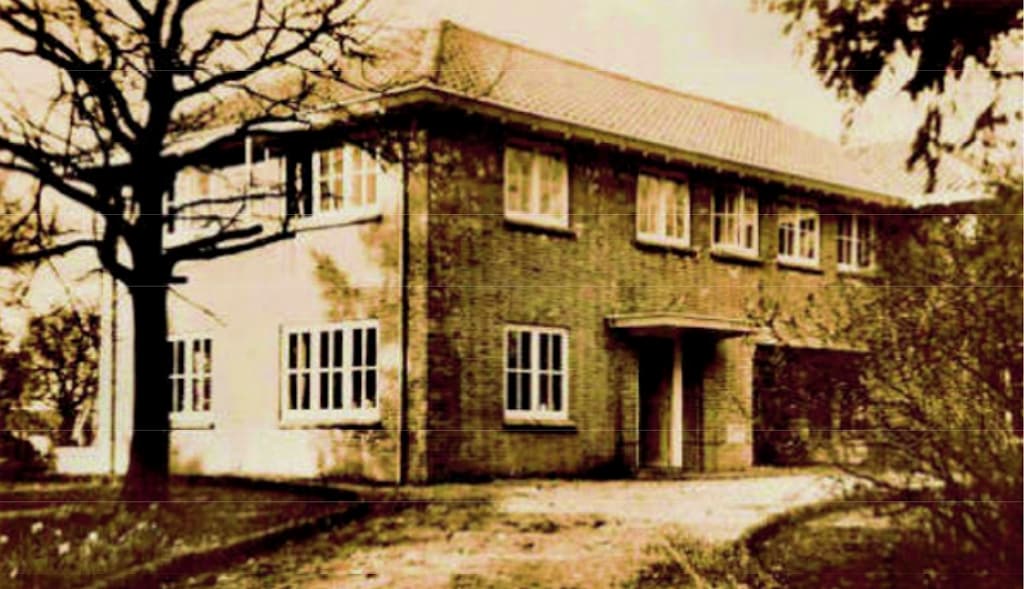Some time ago, when I was finally able to buy the original edition of “Der Dachshund” by Emil Ilgner (published by J. Neumann, 1896), I paused immediately at the third illustration of a dachshund of that time on page 10, because of the caption read “Schlaula – Reinecke (black with rusty brown) owner R. Benda, Biesenthal”.
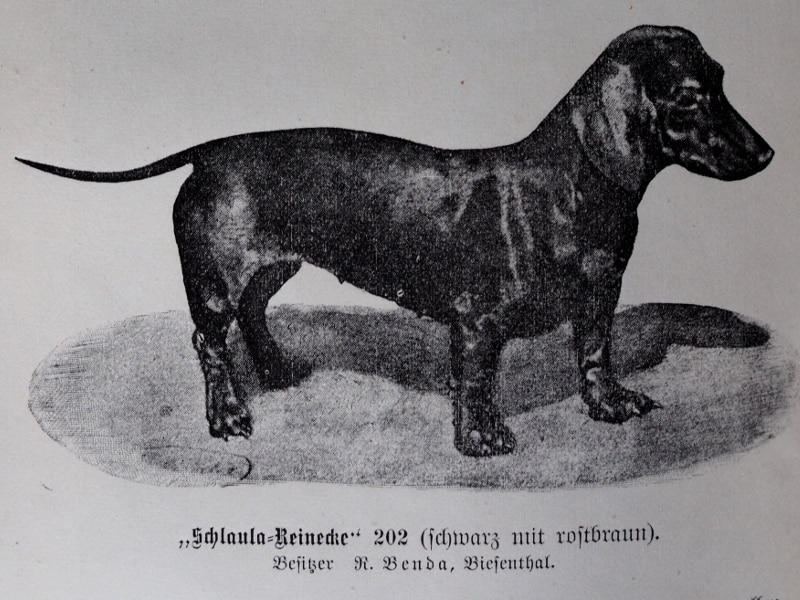
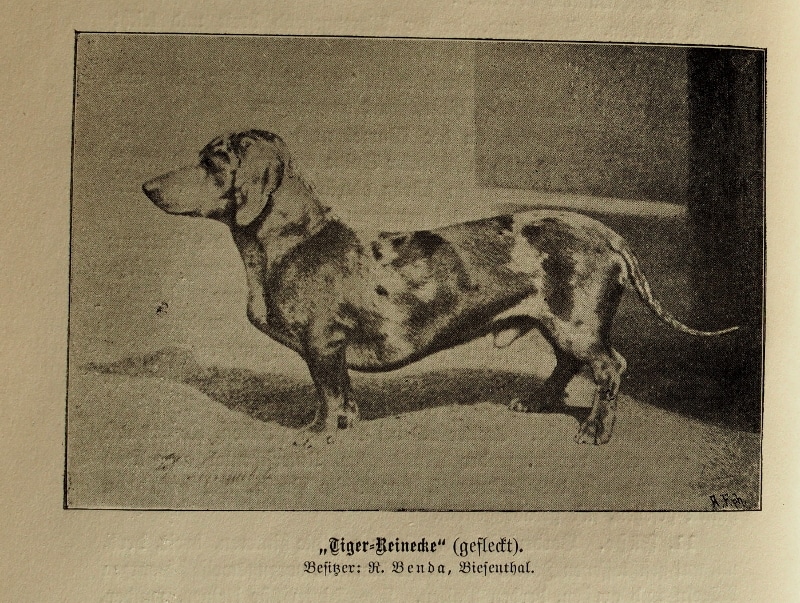
As we were in the process of acquiring a property in Biesenthal to make life nice for us and the Botzensteiners’ dachshunds, this naturally attracted my attention, especially as this was followed by more pictures of smooth-haired and wire-haired dachshunds, especially dapple dachshunds, from this kennel. So coincidence was at work again, I thought, and let my eyes wander benevolently over our own dapples.
First Name Discovery
“R. Benda” did not seem to be an insignificant figure in the dachshund world and I searched the internet to find out more. I was bitterly disappointed. More than that there had been a president (sic!) R. Benda from 1890 to 1896 was not to be found out even on dachshund-specific internet representations. It was pleasant to read that “R. Benda” also took part in the founding meeting of the “Verein Hirschmann” (Hannoverscher Schweißhund) in 1894. Even a call to the office of the DTK in search of possible archives revealed nothing but desolation. What was not thrown away immediately after a burst pipe was just stored in the cellar, probably composting away. It is questionable whether there were any documents left at all, because in 1944 the former office of the Dachshund Association, in which the DTK had merged at the time, was hit by a bomb and all the documents there were destroyed.
However, Benda appears in the list of subscribers to the edition of Frederick the Great’s works ordered by Volz as “Benda, Richard, Rentier u. Ltn. a.D., Biesenthal,”. The publication of the collected works of Frederick, who was considered forgotten at the time, was celebrated at the time as a patriotic feat of renewal and recollection and could only be achieved economically through the advance financing of subscribers, which is why they were mentioned separately. So there we have a first name. There you go!
Beginnings of the Dachshund Club
It is generally known that Emil Ilgner was a co-founder of the Teckelklub in 1888 (R. Benda was also a founding member) and its first and sole chairman; quasi treasurer, secretary and chairman in one. It is less well known that the Teckelklub and the cause of the dachshund hardly made any progress in the first years after the founding of the club. The number of members soon reached a peak of around 30, but it quickly levelled off again at around 20 and stagnated. The main reason for this, apart from the almost complete absence of a real club life, was the rather high annual dues. From 1890 these were halved and regular monthly meetings were introduced. Membership quickly climbed towards 100, so that in May 1890 in Charlottenburg a multi-member executive committee was appointed for the first time with Ilgner as chairman. Whatever the reasons may have been, Ilgner withdrew from the chairmanship immediately afterwards and Richard Benda took over, of whom Ilgner was later to write “He was really a distinguished character who actually only lived for his dachshunds. His kennel ‘Reinecke’ enjoyed a great reputation at home and abroad”.

For all the merits that Emil Ilgner undoubtedly deserves in founding the dachshund club, I do not think it is an exaggeration to say that perhaps the greater credit should go to Richard Benda, who upgraded the small boat created by Ilgner and took it on great voyages across the open sea.
He, not Ilgner, played a major role in the development of the breed standard 1895, the first breed standard written completely independently by the Teckelklub. While Ilgner, as mentioned above, presided over a club with about 20 to 30 members, the number of members grew rapidly under Benda and in 1894, for example, already numbered 250, including 88 hunters. Richard Benda was probably also a practical man, because he made sure that the artificial structures for the Schliefen work were equipped with gates. This created equal opportunities and prevented one hound from catching the fox right at the entrance, while the other hound first had to search the entire den to find the fox. The artificial burrow as it is still used today thus essentially goes back to Richard Benda.
In any case, on 31 May 1891, the Preußischer Stadt- und Landboten (Prussian City and Country Messenger) published the following: “The pensioner Benda from Lanke wants to run a large-scale dog breeding farm here. He has acquired 5 acres of land from the town for this purpose.” Lanke is a neighbouring village of Biesenthal, about 4 km away, and today it gives its name to an exit of the A 11 motorway (Berlin – Pomellen). To avoid misunderstandings about the word ” pensioner”: It is a term for people who live off their investment income without pursuing a trade or profession, not at all for recipients of any kind of retirement income.
After some back and forth – it seems that the intended “dog breeding on a grand scale” was not suitable to trigger enthusiasm everywhere – Lieutenant (ret.) Benda is finally able to submit a building application together with the building drawing to the magistrate on 21 July 1891. On the same day, the city council gives its formal approval to the purchase contract with the municipality in public session and – today’s builders are amazed – only two months later, on 21 September 1891, Mr. Benda can apply to the local police administration for approval of the shell of his almost square villa with two full storeys. “On behalf of Mr. Benda, I would like to inform you that the building shell can be approved. – With the request for a speedy completion, I respectfully sign, F. Grüneberg, master carpenter”. The Prussian carpenters were not poets, but they were obviously skilled craftsmen.
Villa Benda – Dog Breeding on a Grand Scale
The villa built by Benda still stands today in Biesenthal near Bernau in Brandenburg at the current address of Bahnhofstraße 105. A daycare facility for children has been located in this building and part of the original property since 1964.
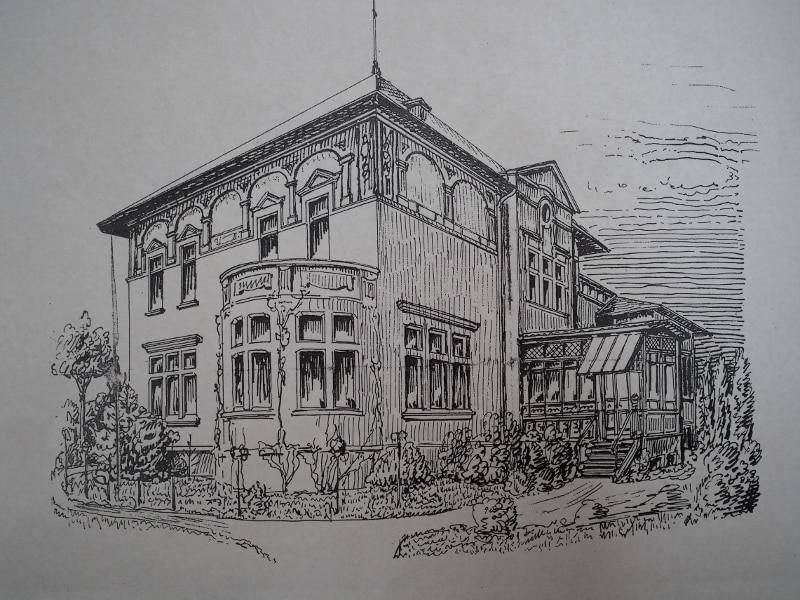

Despite many additions and alterations and a division of the plot (fortunately, the forest plot that was separated has remained undeveloped so far (2016)), the original layout with the main house, the adjoining farm building (itself a stately residence by today’s standards) to the side and offset to the rear at a suitable distance, forming a square courtyard, and the openwork wall connecting the two buildings and demarcating the residential plot from the rest of the property can still be clearly recognized.
Where “dog breeding on a grand scale” used to take place – beyond the wall – is now partly the children’s playground. The levelling that has taken place, which continues beyond the boundaries of today’s kindergarten, and the tree population that is still partially present there, which is not typical for the area, allow us to understand the stately dimensions of the original park-like grounds.
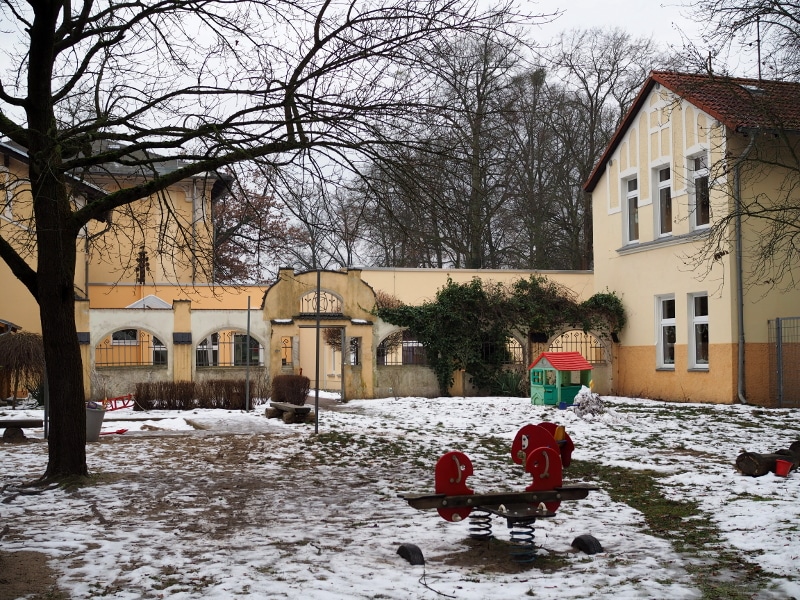
We can only speculate about the reasons for Mr Benda’s relocation to Biesenthal. Why does someone go to considerable expense and invest considerable financial resources in 1891 just to move from an admittedly small village 4 km away to a small town that is not exactly vibrant either? It may be that the local convalescent home of the Gardes du Corps, perhaps the election the previous year as chairman of the dachshund club and the accompanying need for representation, but certainly the rapid upswing in railway traffic in the days of horse-drawn carriages played a role.
The Berlin – Eberswalde railway line had been in operation since 1842. At first it ran far past the climatic health resort of Biesenthal. With the establishment of a stop at Biesenthal in August 1843 and the extension of the line to Szczecin immediately afterwards, the town visibly stretched eastwards. After the 1891 unification with the domainenfiskalische Gutsbezirk Colonie Biesenthal, located between the town and the railway station, the development of the long “Chausseeweg zum Bahnhof”, initially a simple sandy path, was a logical consequence. Considering that Ilgner at the time assumed as a matter of course that bitches in heat would be shipped by train, it is not surprising that Villa Benda was built only a little more than 500m from the railway station. All the less so because Richard Benda was also active as a show judge nationally and internationally.
The fact that Mr Benda also sought contact with the world through one of the first telephone connections in Biesenthal – telephone number 19 – fits into this picture.
Benda Family from Charlottenburg
Hunting and dog sports, as breeding, showing and working were called in those days, were at that time, apart from professional hunters, exclusively something for people of status and – as the building of the villa shows – some wealth. People who made a living in those days did not tend to pitch their tents here and there. There was and still is a castle in Lanke – today a hotel – but Mr Benda had no apparent connection to it; it was owned by the von Redern family. In addition, apart from the castle, a farmhouse and a fisherman’s house, Lanke, including the church, was completely burnt down in 1866. So how does someone from Lanke come into money?
The first walks took me to the cemeteries of Lanke and Biesenthal. Perhaps there were traces of a Benda family to be found there? Lanke was a disappointment in this respect. A tiny little cemetery that seemed to confirm all the preconceptions about Neufünfland. Young and recent graves, nothing old, no Benda family; it seemed as if someone had flattened the cemetery except for two or three picturesque graves and only recently put it back into use.
In Biesenthal, unfortunately, the picture is not much better from my point of view: although the cemetery is large and has interesting grave monuments from many epochs and a Jewish cemetery (however, the Jews who had been resident here since 1671 had already been expelled as scapegoats for one of the town fires in the 18th century, which did not prevent the cemetery from being devastated for safety during the Nazi era), there is no grave with the name Benda.
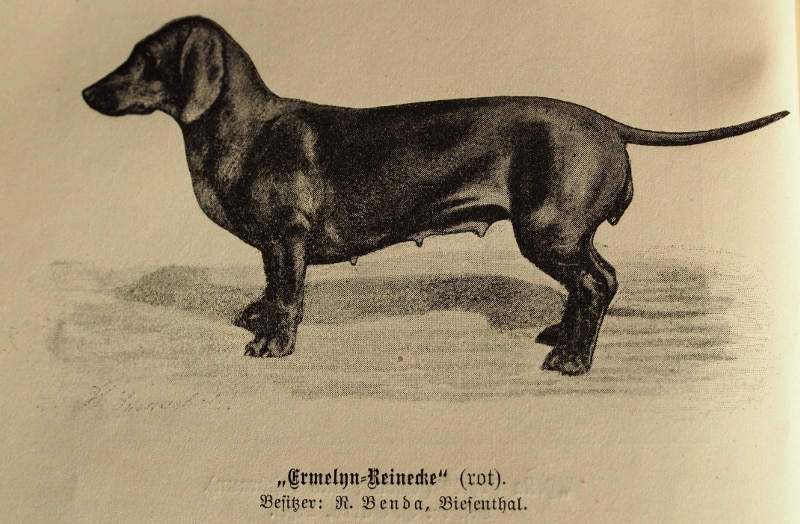
Finally, the district archive of the Barnim district in Eberswalde helped. There you will find the death certificate 37/1921 of the registry office of Biesenthal dated 20 July 1921, which reads: “Before the undersigned registrar, the mayor Bernhard Steller (…) appeared today, known by his personality, and indicated that the pensioner Heinrich Richard Benda, 64 years old (…) living in Biesenthal, Bahnhofstraße 101a, born in Berlin, married to Margarete, née Altmann, in Biesenthal, died in his apartment on nineteenth July of the year one thousand nine hundred and twenty-one in the afternoon at seven o’clock.”.
It thus seems certain that Lanke was only a stopover, if at all. There is much to suggest that Benda took his time looking for a place to settle down after leaving active service. For example, the design drawing attached to the building application of 1891 shows a view of a country house in the English style (which was never built) and is headed as a design for a “country house of Mr. Rentier Benda in Liebenwalde”. Without going too far into speculation, we can assume that Richard Benda was specifically looking for a property in an area rich in wildlife.
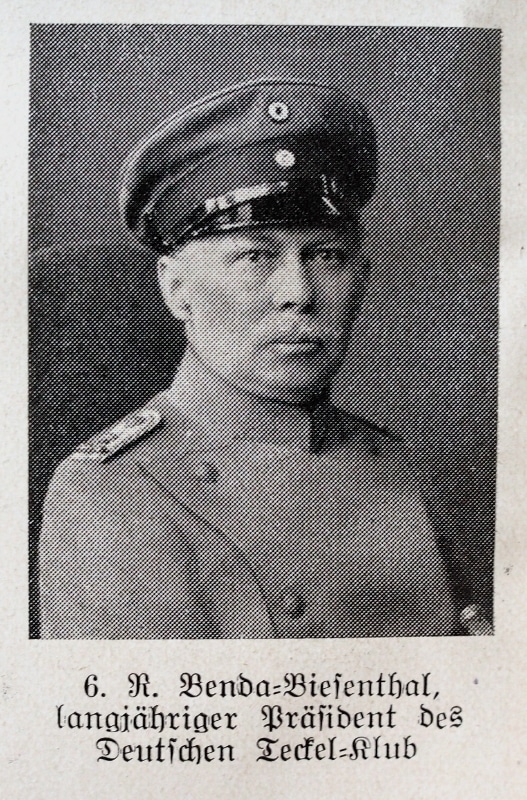
If we assume the age information from the death certificate to be correct, then Mr. Benda had become chairman of the dachshund club and lieutenant of the Landwehr cavalry at the age of just 34 in 1891. The latter, together with the other information “Leutnant der Reserve” or “Leutnant a.D.”, supports the assumption that Mr. Benda did not acquire his fortune through his own efforts, but rather came from a wealthy family, because being a lieutenant at that time was, financially speaking, a considerable extra income, even in active service. A lieutenant in the Prussian army could not and should not live on his pay. Even after the abolition of the privilege of nobility, this was to ensure that no members of “classes unworthy of officers” were given access to the officer’s career. Consequently, only from the rank of “major upwards” was there pay that could have provided a livelihood for a family.
In any case, the new citizen Benda subsequently made a significant contribution to the community of Biesenthal. The Prussian Stadt und Landbote of 17 December 1898 reports on the elections for a replacement town councillor held on 14 December:
“(…) In the first section, of 28 registered voters, 15 voted. All 15 votes went to the pensioner Benda, who was also elected as town councillor for the period until the end of 1899.” The reader should not be surprised at the small number of eligible voters: we are still in the days of three-class suffrage for men only. The male taxpayers of a local authority are allocated to three groups, starting with the men with the lowest tax revenue, in such a way that each group ends up representing about 1/3 of the tax revenue of the body, and each group then elects 1/3 of the mandates to be allocated. (Alfred Krupp, for example, voted alone in the first division in Essen and thus determined at least 1/3 of the city’s policy).
Heinrich Richard Benda was a town councillor until 1912 and was mainly concerned with economic and building matters, especially road construction, as the Preußische Stadt- und Landbote (Prussian Town and Country Messenger) reports from time to time over the following years. On 2 December 1906, for example, it reported: “Lieutenant (ret.) Benda deserves renewed thanks for the fact that, in the joyful exercise of a sense worthy of imitation for the general public, he has had stone steps delivered and laid on the large Schloßberge at his own expense again this year.
The big event in those years, however, remains publicly unmentioned. In 1903 Heinrich Richard Benda marries. From the marriage certificate no. 242/1903 of the registry office Deutsch Wilmersdorf we learn that he – identified by hunting licence – marries the 45-year-old and thus three years older Margarete Altmann on 28 November. In addition to the age difference, another rather unusual detail for that time stands out: Mrs Altmann is a divorced Schoenau. We do not know whether this is a spicy story or simply a socially and economically sensible arrangement. In any case, Mrs. Altmann, even though she had outgrown her marriageable age, was the daughter of the “liqueur and essence manufacturer” Josef Altmann, which, according to Ilgner, would hardly have bothered Heinrich Richard Benda, who lived only for his dachshunds.
The marriage certificate gives us for the first time the concrete date of birth of Heinrich Richard Benda, 08 January 1857, and also solves the riddle of the place of birth. Not “Berlin”, as stated in the death certificate, or Lanke, but Charlottenburg, or more precisely Westend, at that time still an independent municipality like Wilmersdorf, heard the first cries of little Richard as the son of the royal head forester Heinrich Otto Ludwig Alexander Benda and his wife Anna Mary née Knight (according to other sources Anne Mary). The baptism took place 2 months later at the Protestant church of St. Nikolai in Spandau.
The parental home does not seem to lack patriotic sentiments, as befitted an administrative official of the higher service, which was a head forester. According to Louis Schneider, Duncker 1872, “Frau Oberförster Anna Mary Benda, née Knight zu Westend bei Charlottenburg” was awarded the “Cross of Merit for Women and Virgins”, donated at the suggestion of Empress Augusta by Emperor Wilhelm I. The corresponding patent dates from the 18th century. The corresponding patent is dated 18 June 1871, the date of the victory celebration over France declared as a “festival of peace and thanksgiving”. The award was intended as a supplement to the Order of the Louisen, the highest Prussian ladies’ order, which was founded in 1814 and whose recipients had to be Prussian citizens and could not exceed 100.
The ranking list of the Royal Saxon Army, XII Army Corps of the German Army. Army, (after the foundation of the German Empire in 1871) XII Army Corps of the German Army, shows Cadet Heinrich Richard Benda as a member of the Cadet Corps, II Division, and the “Rank and Quarter List of the Royal Prussian Army for 1891” lists him in the rank of Seconde – Lieutenant of Cavalry as a district officer of the Landwehr District of Jüterbog. As a rule, district officers of the Landwehr were no longer in active service.
Sale of Villa Benda
World War 1914-18 also put an end to the orderly life in Biesenthal and even more so in the Benda house. The year 1916 brought deserved recognition in the form of the appointment as honorary chairman of the dachshund club. In 1918, however, Heinrich Richard Benda sold his property at Bahnhofstraße 105. After the World War, the address book lists a retired Major Paul Langenstrass as the new owner of the Benda villa in 1919, who transferred the property to the town in 1963 with the stipulation that it be used for social purposes and then moved to the west.
Oral tradition has it that inflation had a severe impact on Mr. Benda and forced him to sell the villa. However, it seems more likely to me from the passage of time that Heinrich Richard Benda, like so many others, had largely destroyed his capital by subscribing to war bonds that had become worthless by 1918 at the latest. He therefore had to turn his property into cash and settled as a tenant in the immediate vicinity on the much smaller building and property at Bahnhofstraße 101a. The proceeds from the sale – and with it Benda’s livelihood as a whole – may actually have been wiped out by the onset of hyperinflation. After all, in October 1921 the mark was only one hundredth of its 1914 value. This, however, is speculation, even though it is noticeable that the former mayor, who was active during Benda’s city council times, was called in to report the death, which occurred at a relatively young age, to the registry office, and his lingering authority would have prevented any questions from going too far.
In its own way a very German life, like so many and like all others not worth forgetting and reducing it to “R. Benda”.
*We would like to thank for valuable suggestions, information and help above all
- Mrs. Gertrud Poppe, Biesenthal
- The town of Biesenthal
- The district archive of the Barnim district, Eberswalde
- The library of the “Academy of the Federal Armed Forces for Information and Communication (AiK)”, Strausberg
- Mrs. Hilda ten Kate and Mr. Herman Nijhuis, NL-Elim, successful breeders and faithful archivists in matters of dachshunds
You might also be interested in


